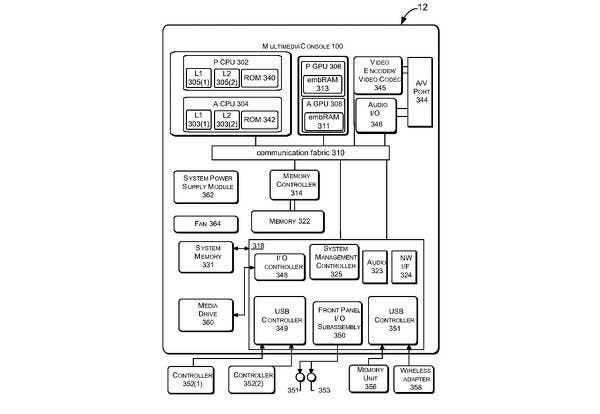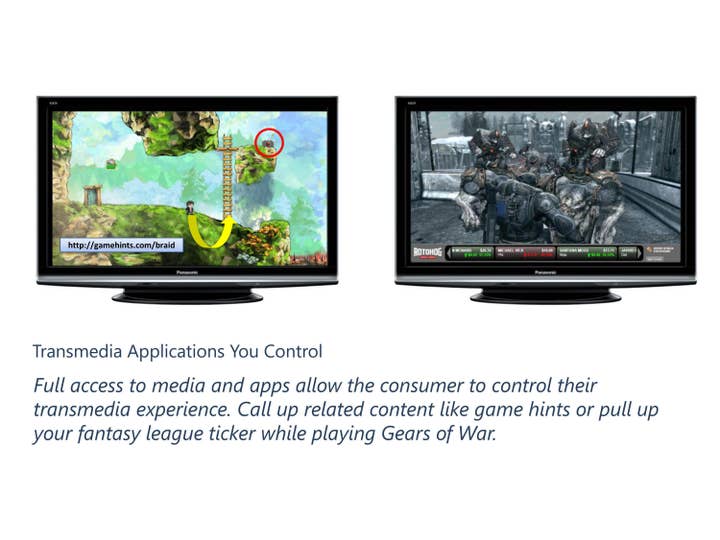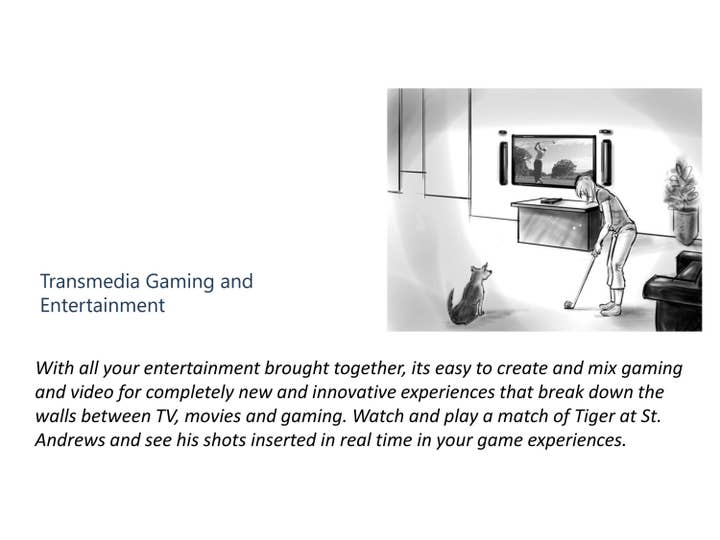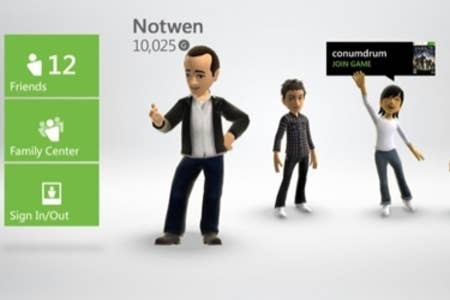The OS Factor and the Rise of Transmedia Gaming
Digital Foundry on why Wii U dedicates 1GB to its background operating system - and how Durango could see that double
Ask just about any games developer what they want they want most from a console and almost always the response will be "more memory" yet the trend in console hardware development is to dedicate ever-increasing amounts of RAM to the operating system. Why?
Perhaps the most high profile example of this recently is the Nintendo Wii U - 1GB of memory sounds positively luxurious compared to the sub-512MB available to developers of PlayStation 3 and Xbox 360 games, but it's actually just 50 per cent of the total onboard memory of the machine - another 1GB set aside for the operating system. And it's not just Wii U either - though established figures aren't in the public domain, both 3DS and PlayStation Vita dedicate generous amounts of memory to the OS - RAM which could be gifted to developers.
"Game devs covet RAM more than any other console component, but the trend is towards dedicating more to the background OS. Platform holders are adapting to the growing demand from gamers for their machines to do more"
So what's going on? Put simply, the platform holders have cottoned on to the fact that gamers want more from their devices and they want instant access to more features in a seamless manner during gameplay. On a mobile platform in particular, this is a natural progression, with the rise of social media a major factor in this. While major OS functions such as the Vita browser can't operate in parallel with gameplay, certain apps work without dumping you out of the game - for example you can capture a screenshot in-game, beam it out via Twitter, and return to the action without a hitch. 3DS's StreetPass feature is another case altogether - a value-added extra that works in the background whether you're gaming or not. What they have in common is the requirement for system resources - and RAM in particular.
The Wii U's 1GB of reserved RAM is something a little different though, the extent of which we've yet to see fully demonstrated. We've had a hint however - in Nintendo's press video for Wii U, we see the gamer unable to progress past a boss, breaking off from the action to make a video call to a buddy for hints and tips. Other uses for this substantial amount of reserve memory are unclear, but it's easy to see a situation where selected OS-level apps and libraries could run semi-independently on the tablet controller without having to quit out of the main game. But what about actually running varied applications along these lines in concert with any game at any time, without impacting on performance?
Microsoft and its next generation Xbox appears to offer up the most ambitious plans for a console operating system going forward. On the 360, the OS - with technical underpinnings going all the way back to Windows NT - occupies a mere 32MB of system space, but according to a well-placed source who has worked directly on major first party Microsoft console titles, the new Durango sees OS resources increase enormously.

Based on this information, the next-gen Xbox could feature 8GB of memory in total, with up to 2GB reserved for OS functions - a phenomenal figure when compared, say, to the 1GB total found in the iPhone 5. Microsoft's vision for the next-gen OS is ambitious in scope: both the leaked Xbox 720 discussion document and the firm's own 2010 patent applications suggest that the OS - or "platform" as it is described - have dedicated CPU and GPU components, separate and distinct from the resources available to developers, who only have direct access the "application" areas of the hardware.
"If the rumours are true, Durango doesn't just dedicate 2GB to the OS but significant CPU and GPU resources too - an enormous investment from Microsoft"
The patent application itself is an in-depth filing on how Microsoft's engineers reconcile two internal architectures within a single box, balancing components in order to guarantee quality of service from both simultaneously. In short, the design strongly suggests that the next Xbox will run OS-level apps and games at the same time - an extreme implementation of multi-tasking, if you will.
Running apps concurrently with gameplay is nothing new on PC of course: whether you're running Skype in the background as you play, or even just keeping your email client open, you are using the multi-tasking elements of your PC naturally, as a matter of course, even if they conflict with, or impact performance of the games you are playing. In a console environment where developers rely upon a fixed architecture with known performance levels, the notion of apps interfering with the operation of gameplay simply wouldn't work. It's for exactly this reason that the examples we've seen of OS functions on Vita and Wii U require the game to be paused first.
But just what kinds of applications would require such a prodigious amount of processing power and RAM? What we are looking at is a considerable amount of silicon that could be used to further bolster the gaming potential of the console, but instead it is being reserved for the "platform", for elements that developers may have little or no access to.
For a long time the platform holders have coveted set-top box status in the living room, but it's only through the advent of streaming video - Netflix in particular - that consoles have actually become widely-used media playback machines. The natural progression from here is to migrate towards full PVR functionality, with the option of using the new console as a media server, able to stream content elsewhere in the home, while downloading further content in the background, all the while leaving "application" resources - games, in other words - running as smoothly as ever.
However, on a more general level, Microsoft is surely adapting to the ways in which people interact with technology and are looking to somehow integrate that more closely into gameplay. Examples shown on a basic level in the 720 leak include customised ticker-tape feeds that could be superimposed onto the screen, presumably encompassing social media feeds.


Also, expect both Sony and Microsoft to bolster the ability to share in-game video and screenshot assets in their next-gen hardware. Most high-end GPUs these days have hardware video encoders built-in and this functionality is a natural fit for next-gen consoles: players may even be able to livestream their own gameplay. An onboard video encoder would have useful, if rather more mundane uses too: the same tech could be used to re-encode downloaded video to beam across to other devices for example, and even power videochat during gameplay (don't forget that MS now owns Skype). On a more practical level, the ability to merge OS-level programs and gameplay could allow for strategy guides to become far more contextual in nature, offering up in-game maps and video based on your actual level of progress.
"Durango sounds like an ambitious design, arguably somewhat over-engineered for a games console, and the question is to what extent these elements will offer value to the audience"
The leaked 720 discussion document goes much further than this, hinting at an actual revolution in gameplay, with Microsoft suggesting that video transmissions could be integrated into games themselves - an innovation it refers to as "transmedia gameplay". The demonstration it offers is of a live golfing event, where Tiger Woods PGA-style action plays out side-by-side with an actual golfing tournament, the player himself integrated into the contest as it actually happens.
The applications here - particularly in terms of sports - are enormous: why stop at golf? If the means becomes available to beam telemetry from sporting events to the home, F1 games could produce real-time rendered representations of live events that work alongside the televised video stream, the telemetry data then implanted into actual gameplay directly after the race is finished. Watch the race in a way you've never been able to experience before, then become part of it - an intriguing proposition, for sure.
Of course, the transmedia gaming concept could simply be a flight of fancy from Microsoft, hailing from a period back in summer 2010 where Durango was still in its formative stages. A lot could have changed since then - the 720 strategy document hints at OnLive as a potential acquisition target and as cloud streaming as a must-have feature, something that is probably far less of a factor for Microsoft now.
But the OS's ballooning RAM allocation, including dedicated processing units for OS-level functions - these are elements of the Durango spec that are looking more and more like a lock for the final retail machine. It's an ambitious design, arguably somewhat over-engineered for a games console, and the question is to what extent these features will offer value to the audience - we can only speculate for now, and even our best guesses can't justify to us the sheer expensive of this approach. What is curious is that it's Microsoft that is making the running here: everything we have heard so far about Orbis, or PlayStation 4, is that its technical make-up has far more in common with what you would expect from a next-gen console design - essentially a PC boiled down into a smaller, console-sized box.
Could transmedia gameplay or some other feature embedded into Durango give it a unique selling point, in the way that motion control disrupted the current generation? If the rumours are true, Microsoft will certainly be hoping so, based simply on the huge investment it would have made in terms of both R&D and production of the final silicon.









